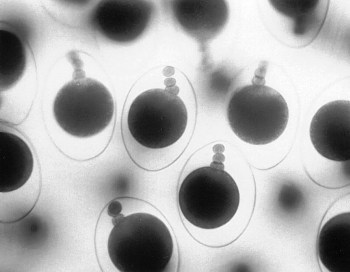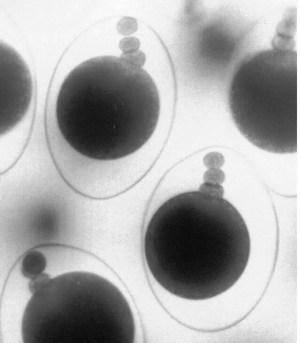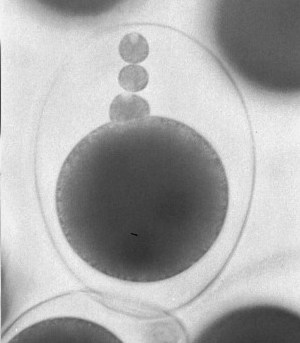Cuthona lagunae - feeding & embryology
July 12, 2000
From: Jeff Goddard

PHOTOS: The uncleaved eggs and polar bodies inside the egg capsules of Cuthona lagunae. The eggs in this particular egg mass averaged 102 microns in diameter. (see below for photos at higher magnifications).
Hi Bill,
The aeolids in Clinton Bauder's photos are definitely Cuthona lagunae. As you correctly point out, the combination of white cephalic tentacles, orange rhinophores and patch on the head, white stripe on the tail, and green and orange cerata is distinctive.
In southern Oregon and northern California I have consistently found Cuthona lagunae on the thecate hydroid Sertularella turgida (see Goddard, 1987, personal observations), which appears to be present slightly below and to the left of the specimen in Clinton's lower photo. I have not, however, actually observed feeding by the aeolid on this hydroid.
This is one of my favorite aeolids, owing to its conspicuous color pattern and interesting embryonic development. Shortly after egg laying and fertilization, the eggs of Cuthona lagunae extrude some of the largest polar bodies known in the animal kingdom (see attached photos). These eventually detach from the developing embryos and are later ingested whole by the embryonic veligers prior to hatching (Goddard, 1991 and unpublished observations). The polar bodies thus constitute a unique source of extra zygotic yolk. The function, if any exists, of this yolk is unknown, but it may accelerate embryonic development slightly by reducing the amount of yolk which must be cleaved by the embryo, or perhaps "prime" the embryonic veligers for feeding in the plankton.
Like other members of the Tergipedidae (but in contrast to most other nudibranchs), the planktotrophic veligers of Cuthona lagunae hatch with egg shaped shells that do not increase in size during the larval stage. Rather, the tissues of the veliger grow to fill the initially spacious shell.
References:
• Goddard, J. H. R. (1987) Observations on the opisthobranch molluscs of Punta Gorda, California, with notes on the distribution and biology of Crimora coneja. The Veliger, 29(3):267-273.
• Goddard, J. H. R. 1991. Unusually large polar bodies in an aeolid nudibranch: a novel mechanism for producing extra-embryonic yolk reserves. Journal of Molluscan Studies, 57 (supplement):143-152
Best wishes,
Jeff
goddard@lifesci.ucsb.edu


Dear Jeff,
Thanks for the interesting photos and observations on the strange polar bodies in this animal. I remember your paper in the Tom Thompson memorial supplement to the Journal of Molluscan Studies. Have you had a chance to check any other species for a similar phenomenon?
Best wishes,
Bill Rudman.
Related messages
-
Cuthona lagunae from Monterey, CA
From: Clinton Bauder, February 10, 2006 -
Re: Cuthona fulgens? from California
From: Jeff Goddard, September 30, 2005 -
Re: Cuthona fulgens? from California
From: Dave Behrens, September 30, 2005 -
Cuthona fulgens? from California
From: Dr. Steve Lonhart, September 29, 2005 -
Cuthona lagunae from California
From: Jeff Goddard, June 6, 2005 -
More on the unusual eggs of Cuthona lagunae
From: Jeff Goddard, June 6, 2005 -
More on Cuthona lagunae
From: Jeff Goddard, July 13, 2000 -
Cuthona lagunae? from California
From: Clinton Bauder, July 11, 2000
